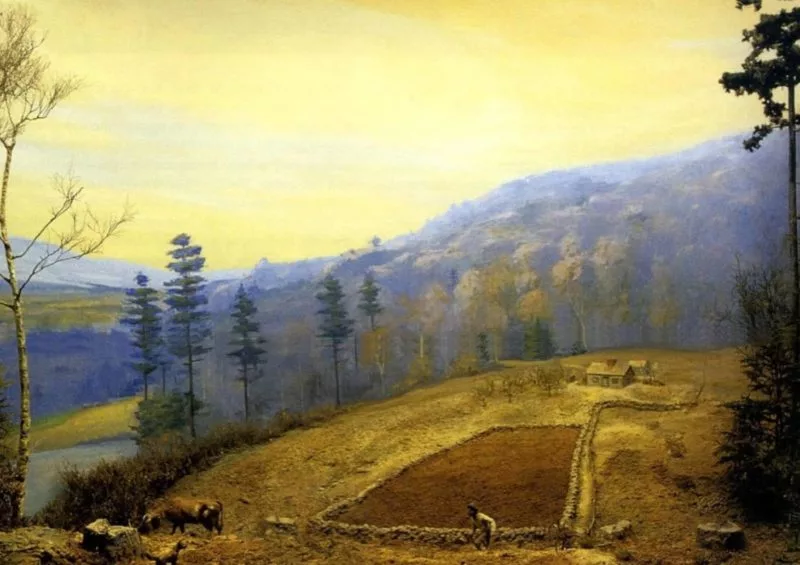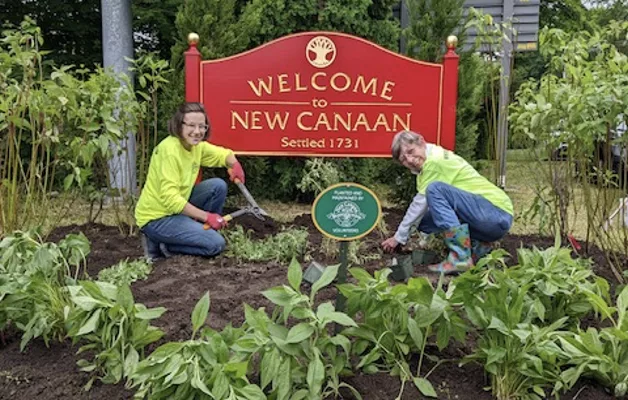
By Anne W. Semmes
Those stone walls found about our town are a most distinctive feature, and they have a distinctive history, in fact layers of history tracing back to the last ice age! Here to tell that tale last Sunday was ecologist and climate change Professor Dr. Mitch Wagener of Western Connecticut State University in Danbury. “The ice ages are important for humans and also important for the story of the stone walls because we are the children of the ice ages.”
Wagener is a captivating speaker, often referring to his academic years in Fairbanks, Alaska. He has spoken at the Bruce Museum once before which sponsors the Fred Elser Sunday Science lecture series held at the seaside center of Innis Arden Cottage at Greenwich Point.
“Now 16,000 years ago, Connecticut in general would’ve looked something like this.” He shows a photo of Greenland – “We would be about a mile thick layer of ice…at the glacial maximum before the global climate changed and the ice began to melt in place… And when the glaciers began to melt, anything they carried or pushed stayed put. That’s where the stones got here.”

So that melting ice contained “a lot of pulverized rock called glacial flour because it’s kind of the consistency of flour like you make bread from,” he says. What might look muddy is “ground up rock.” And then he shows a telling panorama titled “Primary Succession” that spells out how that bare rock-to-become stones eventually becomes buried underground. “And you see the beginning of a forest coming up through it.”
“And if it’s Connecticut, it’s a forest, it’s called Primary Succession,” he tells. “But it takes hundreds of years for primary succession. Pine trees are actually mid succession here because pines seedlings need lots of sunlight to get started. And so gradually the pines are replaced by hardwood trees that can tolerate some shade and eventually get oak and hickory.
“So, as of 10,000 years ago the first Native Americans arrived…They moved around from location to location with the seasons and where the food resources were. And so therefore their houses were not permanent structures – they were able to move around to corn growing season, to fishing season, to whatever season it was.”
“They did not have domestic animals. They didn’t need to build obstructions to keep those animals out,” he said. But “When the Europeans came, they were bringing their farm animals, their horses and goats and chickens and ducks and geese and sheep and cows. They also brought a culture that suggests expressing ownership of a property was to improve it in some fashion, and to improve that area meant building walls around it, so you know which part is yours and which parts are the next guy’s over there.”
So, there were a lot of tree felling to build those walls, and those houses. All fine for those British colonists “because the wood and the wood lots were owned only by the people of wealth back in Britain…So by 1776 during the American Revolution, the farmers found that they were running out of wood for warming their houses.” But interestingly, continues Wagener, “after every spring frost, after the snows clear, they would find a field full of round stones as if Satan himself had deposited them to test the hearts of the righteous.”
And so, “one of the jobs first thing in the spring was to go and pick up those stones and take them to the edge of the field. And so, the first stone walls, many of them were shaped like the wooden fences they replaced. They’d have like a snake rail stone fence only because you don’t want to carry that stone any farther than you have to – you throw it over the fence.”
But “Later on, they realized that goats and sheep were pretty good at climbing stone fences, and so they had to come up with some new thing to discourage them.” Wire rails were placed on the stone walls (barbed wire was yet to be invented). But then with time those small farmers realized, “They couldn’t make much of a living on their small holding farms – they wanted to do other things.” And fancier stone walls were now surrounding churches and homes “because they look nicer than the ones that are out in the farm fields.”
Add to those influences Cyrus McCormick’s invention of a mechanical reaper used for harvesting wheat and other grass crops. “Stone wall constrained rectangles were too small…So if a farmer is going to continue to farm his area, he had to either take those stones somewhere else to open the fields or bury them…Or they could go out west and in the Ohio Valley where they had larger spaces without their walls, and so a lot of the farms were abandoned – and what happens is Secondary Succession and the trees come back.”
“So that is where the stone walls came from,” he concludes. “They were part of agricultural history early on and then became an impediment that was too hard to deal with. And so, the farmers went elsewhere to do other things.”
Wagener had earlier shared a high-altitude photographic study of how many walls there are in Connecticut – “and it was 20,347 miles of stone walls which is about 33 feet per acre for the whole state.” A U.S. Department of Agriculture estimate from a hundred years ago, he found to have “about the same number.”
He cites those stone walls as “archaeological – they’ll be there for future archaeologists to find, and so they have an out-sized presence in our psyche.” He confesses to having “collected a bunch of stones” and made his own “personal stone wall” in front of his house in Bethel. “I wasn’t going to steal over people’s stones,” he notes. But whenever he’s “digging around and doing gardening and stuff in the backyard” and “hits a nice big rock” he’ll “put it aside. I figure I’m going to add it to my collection.”


